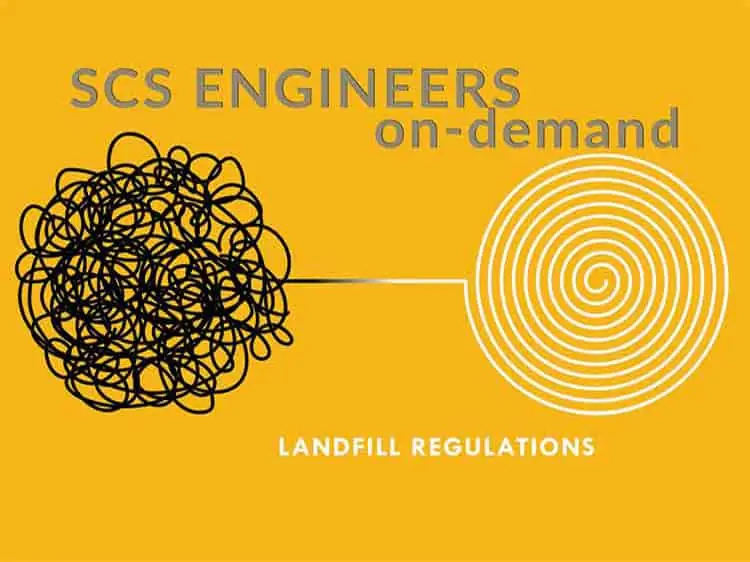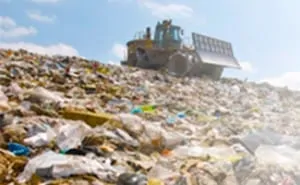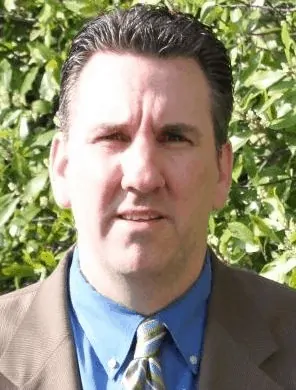


The EPA and, in some cases, states are rolling out new emissions guidelines at least as stringent. The EPA estimates that the plans could cover about 1,600 landfills. These landfills are in 41 states, tribal entities, and the U.S. territories of Puerto Rico and the Virgin Islands.
MSW landfills without Gas Collection and Control Systems (GCCS) that reach a specific threshold will need to add these systems and have 30 months to install or update control systems to meet new standards. As you’ve noticed by now, we’ve greatly oversimplified what is happening.
The new regulations and timetables are difficult to understand and untangle. SCS Engineers, in concert with SCS Field Services, have prepared resources to help during the transition period and afterward when landfills are likely to need more monitoring and measurement, thus creating millions of more bits of data to store, analyze, and report.
We hope you find these resources useful. We will be publishing more soon.
These resources may help you with future monitoring and maintenance:
Thank you to the many folks attending SCS’s live webinar on July 15th about managing the NESHAP, NSPS/EG transition period. As promised, we’ve created a library of resources for you to use and share with your colleagues.
These resources may help you with future monitoring and maintenance:
We’re here to help. Please find an expert or contact us at .
(40 CFR Part 60, Subpart OOO)
On May 21, 2021, EPA published the final MSW Landfills Federal Plan, which implements the 2016 Emission Guidelines (EG Subpart Cf) under 40 CFR Part 62 Subpart OOO. The Federal Plan becomes effective June 21, 2021, and impacts landfills that have not triggered NSPS Subpart XXX requirements and landfills located in states and Indian country without EPA-approved EG Cf rules.
Affected are MSW landfills that commenced construction on or before July 17, 2014, and have not been modified or reconstructed since July 17, 2014.
The Federal Plan requires existing landfills that reach an annual emissions threshold of 34 metric tons of nonmethane organic compounds (NMOC) or more to install a system to collect and control landfill gas (GCCS). It also implements various emission limits, compliance schedules, testing, monitoring, reporting and recordkeeping requirements for GCCSs established in the 2016 Emission Guidelines for MSW Landfills.
The Federal Plan also establishes a definition for “legacy controlled landfills.” These are landfills that have previously satisfied the requirement to submit an initial design capacity report, initial (or annual) NMOC emission rate reports, and collection and control system design plan under 40 CFR part 60, subpart WWW; 40 CFR part 62, subpart GGG; or a state/tribal plan implementing 40 CFR part 60, subpart Cc.
If you are subject to the Federal Plan and are not a “legacy controlled landfill,” you must submit a design capacity report by September 20, 2021. And if the design capacity report indicates a capacity equal to or greater than 2.5 million Mg and 2.5 million m3 of solid waste, you must also submit an initial NMOC emission rate report within 90 days after the effective date of the Federal Plan (September 20, 2021).
SCS is working to develop a Technical Bulletin for distribution to our mailing list and on social media. The Bulletin will consolidate the Final Rule into several pages highlighting significant dates and key impacts for you.
Read and share the full article by David Greene, PE, here.
EPA recently established expansive new air rules affecting MSW Landfills. Implementation of the new rules places new responsibilities on both the regulated community and regulators alike. However, some of these responsibilities are unclear and have created unresolved issues that should be addressed in close consultation now with your state/local regulatory authority.
For example, if a landfill is “new,” the facility is now subject to NSPS Subpart XXX, which is fully effective. A design capacity and NMOC emissions rate report should already have been submitted.
If NMOC emissions from a facility exceed 34 Mg/yr, then the landfill will need to submit a GCCS design plan within 12 months of the date of exceedance and install and operate within 30 months (no later than May 2019 for those triggering with the promulgation of the rule). If a landfill is an “existing emissions source,” it will be subject to the new EG rule (Subpart Cf).
Landfill owners should maintain close contact with their state/local regulatory authority regarding the status of the regulator’s state implementation plan, due by November 2017. That state implementation plan will prescribe the required compliance dates for an existing landfill, likely to be no later than the 2018/2020 time period. In either case, owners should become familiar with the rule and stayed tuned as compliance guidance evolves to address the unresolved issues.
Contact SCS Engineers to discuss the regulatory status in your state at , or call your local representative.
EPA is proposing a GHG SER of 75,000 tons per year (tpy) Carbon Dioxide equivalent (CO2e) and requesting comment on it as well as two lower levels, specifically 30,000 tpy and 45,000 tpy CO2e, respectively.
The Associations do not believe there is sufficient information to support lowering the GHG SER below the proposed 75,000 tpy CO2e level and provided a table utilizing equivalent criteria pollutants from combustion sources (i.e., NOx, CO) yields CO2 emissions as high as 780,000 tpy CO2.
EPA already concluded in USEPA, Proposed PSD Revisions Rule, 81 FR 68137 that the burdens of regulation at a GHG SER level between 30,000 and 75,000 tpy CO2e would yield a gain of trivial or no value from both a programmatic and individual project-level perspective. Therefore, NWRA and SWANA strongly recommend EPA retain proposed GHG SER of 75,000 CO2e (or higher), and resist pressure to lower the GHG SER.
On the Topic of Biogenic GHG Emissions, the EPA’s final rule requires clarification to remain consistent with previous documentation and research to prevent significant permitting delays and increased costs that will not result in meaningful emission reductions.
The Associations encourage the EPA to ensure that waste-derived biogenic CO2 (e.g., from municipal solid waste (MSW) landfills) is treated as carbon neutral under the final PSD Permitting Revisions Rule to be consistent with prior Agency determinations specified in this memorandum and documents as follows:S. EPA, Memorandum Addressing Biogenic Carbon Dioxide Emissions from Stationary Sources, McCabe, Janet, November 19, 2014.
S. EPA, Memorandum Addressing Biogenic Carbon Dioxide Emissions from Stationary Sources, McCabe, Janet, November 19, 2014. The documents highlight waste-derived, biogenic CO2 as a type of “carbon neutral” feedstock based on the conclusions supported by a variety of technical studies and conclusions of the Agency’s latest draft Framework for Assessing Biogenic Carbon Dioxide for Stationary Sources, which was released with the memo. The Agency memo stated that “the Agency expects to recognize the biogenic CO2 emissions and climate policy benefits of such feedstocks in [the] implementation of the CPP.”
US EPA, Emission Guidelines for EGUs, 80 FR 64855. Both the revised Framework, and the EPA’s Scientific Advisory Board (SAB) peer review of the 2011 Draft Framework, found “that the use of biomass feedstocks derived from the decomposition of biogenic waste in landfills, compost facilities, or anaerobic digesters did not constitute a net contribution of biogenic CO2 emissions to the atmosphere.”
S. EPA, Appendix N. of Revised Framework for Assessing biogenic Carbon Dioxide for Stationary Sources, November 2014, pg. N-25. In Appendix N. of the Framework, entitled Emissions from Waste-Derived Biogenic Feedstocks, EPA calculated negative Biogenic Accounting Factors (BAF) for various examples of treatment of landfill gas via collection and combustion. EPA explains, “Negative BAF values indicate that combustion of collected landfill gas feedstock by a stationary source results in a net CO2e emissions reduction relative to releasing collected gas without treatment.”
US EPA, Carbon Pollution Emission Guidelines for Existing Stationary Sources: Electric Generating Units; Final Rule [Emission Guidelines for EGUs], 80 FR 64885. “[T]he use of some biomass-derived fuels can play a role in controlling increases of [in] CO2 levels in the atmosph The use of some kinds of biomass has the potential to offer a wide range of environmental benefits, including carbon benefits.”
US EPA, Emission Guidelines for EGUs, 80 FR 94855. Types of waste-derived biogenic feedstocks may include: landfill gas generated through decomposition of MSW [municipal solid waste] in a landfill; biogas generated from the decomposition of livestock waste, biogenic MSW, and/or other food waste in an anaerobic digester; biogas generated through the treatment of waste water, due to the anaerobic decomposition of biological materials; livestock waste; and the biogenic fraction of MSW at waste-to-energy facilities.
NWRA and SWANA believe the final PSD Revisions document should follow the approach to waste-derived feedstocks enshrined in the Final Clean Power Plan, and as recommended by the SAB, and ensure that waste-derived biogenic CO2 is treated as carbon neutral. Based on EPA’s own lifecycle assessments for the Renewable Fuels Standard program, its U.S. GHG Inventory, and confirmed by the SAB, EPA has sufficient analysis to support exclusion of selected categories of biogenic emissions from PSD permitting, including those from managing landfill gas and organic components of MSW.
The EPA does not seem to consider the regulatory treatment of biogenic CO2 from stationary sources to be a key issue in the context of the PSD revisions rule, based on a comment found in a Summary of Interagency Working Comments on Draft Language. Instead, the EPA continues to believe this rulemaking to establish a GHG SER under the PSD program is not the appropriate venue to address the broader concern of the regulatory treatment of biogenic CO2 from stationary sources.
The Associations strongly disagree and are concerned that because EPA remains silent on this important issue, some permitting authorities might improperly require landfills to incorporate biogenic CO2 emissions in the PSD permitting process. Historically, few landfills triggered PSD because non-methane organics emissions rarely reached the threshold. However, if biogenic CO2 emissions become subject to PSD, many landfill projects, which are “anyway sources” due to renewable energy projects, would also be forced to do BACT analysis for GHG. Biogenic CO2 is emitted from:
From the perspective of developing new renewable transportation fuel or energy projects, subjecting biogenic emissions from landfills to PSD could be an enormous barrier. The Associations would like the EPA to clarify in its final rule that the emissions of biogenic CO2 from treating or controlling landfill gas does not increase the CO2 levels in the atmosphere, but instead, has positive emission reduction and climate benefits. Failing to clarify this important point could subject landfills to significant permitting delays and increased costs that will result in no meaningful emission reductions.
Questions? Contact SWANA, NWRA, Patrick Sullivan, or your local SCS office.
Do you have NSPS or EG sites per the new definitions of “new” and “existing”?
Does your EG site have any upcoming planned or permitted expansions, or will it be commencing construction on an expansion permitted after July 17, 2014?
Will you need to submit/resubmit Design Capacity and NMOC reports to establish your sites status as subject to the new NSPS? Over, or under 34 Mg/year of NMOCs?
Are you a candidate for Tier 4? In the closed landfill subcategory?
For EG sites contact the SCS state representative by sending a request to
SCS Engineers will be publishing Pat Sullivan’s Technical Bulletin Summary of Final NSPS/EG Rules for Landfills as soon as it is published in the federal register. Meanwhile, please contact your SCS Project Manager or for answers to your questions or advice. Follow SCS Engineers on your favorite social media site or check our events for new presentations, publications, and webinars explaining the rules in more detail.
SCS Engineers along with Waste Management, Republic Services, Advanced Disposal, National Waste & Recycling Association, Solid Waste Association of North America, The Sanitation Districts of the County of Los Angeles, and other consultants have submitted additional comments to the U.S. Environmental Protection Agency (USEPA), Fuels & Incineration Group, Sector Policies and Programs Division regarding the Supplemental Proposal for the New Standards of Performance (NSPS) for Municipal Solid Waste (MSW) Landfills and the Proposed Emission Guidelines (EG).
The USEPA solicits comments from industry, state officials and other organizations to clarify key points in proposed policy prior to enacting the policy. Although the Agency is not required to consider additional comments after the closing period for such comments, these solid waste industry participants wanted to provide additional findings supporting portions of the policies and guidelines and asking for clarification in areas where there appears to be inconsistency with other federal rules or a lack of data.
The eighteen-page letter was submitted on January 22, 2016, to Ms. Hillary Ward. Since last Friday inclement weather has forced a closing of Federal Agencies in the Washington, D.C. region.
Click for SCS Engineers compliance information.
Click to contact Pat Sullivan, SCS National Expert on EPA Landfill Clean Air Act; NSPS/EG

SCS Engineers has also submitted comments pertaining to the proposed EG and compliance revisions to the EPA. SCS leaders are involved in many outreach activities to help landfill owners and operators understand and prepare for the impact of the proposed modifications.
Contact SCS Engineers at for more information, or visit the SCS website for upcoming events and pertinent resources.
Reprint

The SWANA Landfill Gas and Biogas Division is very busy right now with several important efforts. On the Rules and Regulations front, the U.S. EPA has promulgated two draft landfill gas (LFG) rules that were published in the Federal Register on August 27, 2015. These include a draft Emission Guideline (EG) rule and a supplemental draft New Source Performance Standards (NSPS) rule.
The proposed EG rule affects “existing” landfill sites (i.e., landfills that have not been expanded and were not newly constructed after July 17, 2014). The NSPS rule is a supplemental proposal that affects “new” landfill sites (landfills that are new or were expanded in capacity after July 17, 2014). Comments on both are due by October 26, 2015. Final issuance of both rules is expected in the first quarter of 2016. The Division Rules and Regulation and Advocacy committees are working together to develop SWANA’s industry comments on the rules.
The major focus of both rules is the current 50 Mg/year of non-methane organic compounds (NMOCs) emission threshold, which triggers the installation of a LFG collection and control system (GCCS). In the proposed rules, that threshold will be lowered to 34 Mg/year for all landfills except existing, closed sites. This appears to be the centerpiece of the U.S. EPA’s plan to create additional NMOC and methane reductions from landfills. With a lowered NMOC threshold, some landfills, particularly those that have been too small to trigger the installation of a GCCS, will be required to install them.
Other key components of the draft EG rule, which are likely to be similar in the NSPS rule, include the following:
The draft EG rule also provides clarifications on several existing rule topics, as well as topics where U.S. EPA decided not to include such items in the rule:
During the comment period, the EPA also is looking for public comment on:
The EPA will have the ability to add more provisions to the final version of the rule based on the information submitted as a part of these information requests. This means the industry must make a strong case to the EPA to get them to consider our opinions on these issues.
Comments on this article should be addressed to Patrick S. Sullivan, Senior Vice President, SCS Engineers, at 916-361-1297 or